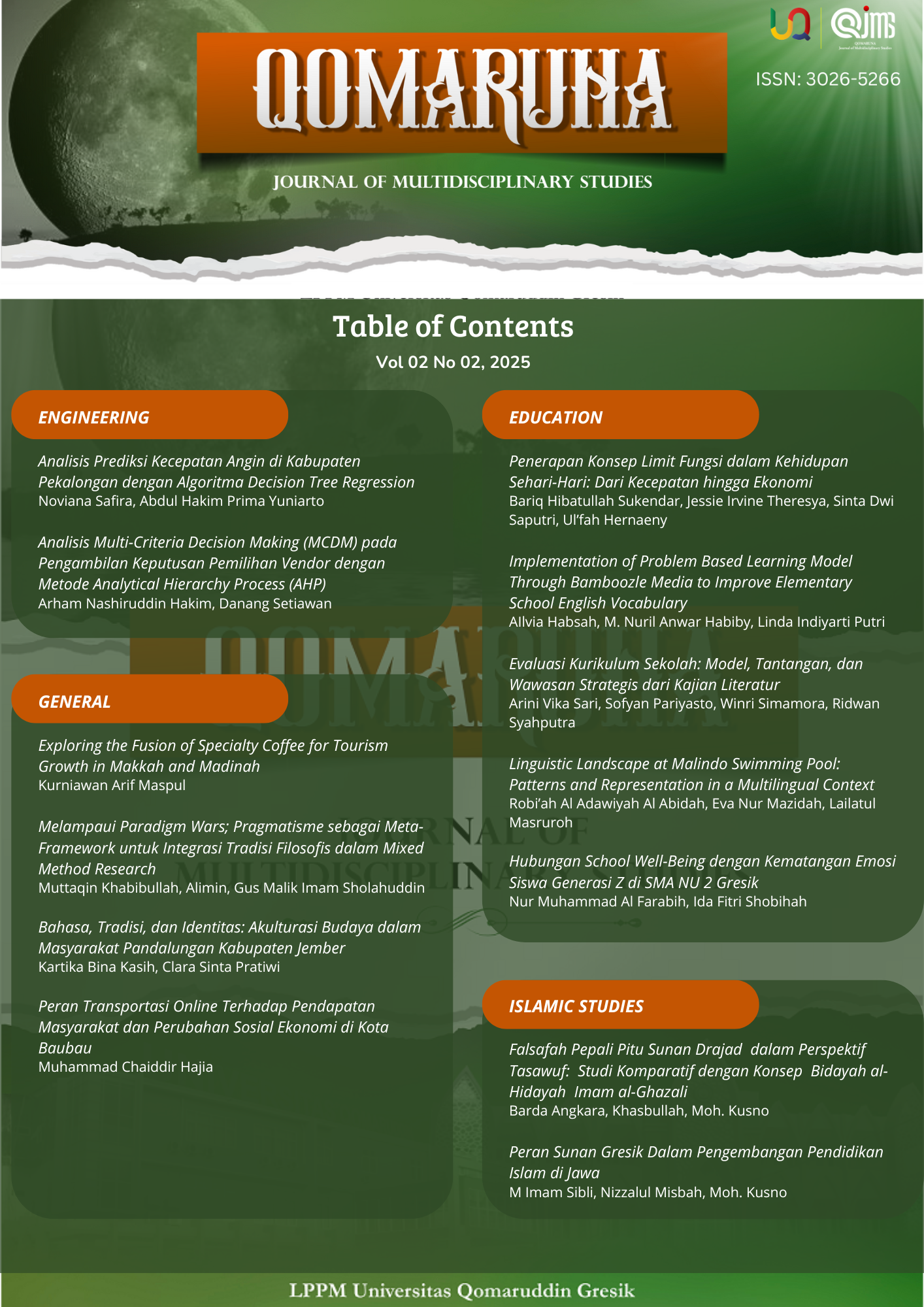Lanskap Linguistik di Kolam Renang Malindo: Pola dan Representasi dalam Konteks Multibahasa
DOI:
https://doi.org/10.62048/qjms.v2i2.87Kata Kunci:
lanskap linguistik, multibahasa, bahasa, ruang publikAbstrak
Penelitian ini mengkaji lanskap linguistik (LL) Kolam Renang Malindo, sebuah ruang publik multibahasa di Gresik, untuk mengeksplorasi pola dan representasi penggunaan bahasa serta implikasi budayanya. Dengan menggunakan metode kualitatif, termasuk dokumentasi visual dan analisis isi, penelitian ini mengidentifikasi fungsi dan representasi bahasa dalam berbagai papan informasi. Hasil penelitian menunjukkan bahwa Bahasa Indonesia mendominasi tanda-tanda praktis guna memastikan kejelasan bagi pengunjung lokal, sementara Bahasa Inggris digunakan secara strategis untuk tujuan branding dan inklusivitas, sehingga menarik bagi khalayak yang lebih luas. Menariknya, tidak adanya bahasa daerah seperti Bahasa Jawa menunjukkan adanya prioritas terhadap komunikasi nasional dan internasional. Analisis semiotik mengungkap makna denotatif dan konotatif dalam lanskap linguistik, yang mencerminkan modernitas, identitas budaya, dan dinamika sosial. Penelitian ini memberikan kontribusi terhadap pemahaman tentang multibahasa di ruang rekreasi publik dan menawarkan wawasan untuk pengelolaan keberagaman bahasa dalam konteks pariwisata.
Referensi
Ardhian, D., & Fajar, Y. (2017). Linguistics landscape in Malang City, East Java. JETAFL (Journal of English Teaching as a Foreign Language), December.
Creswell, J. W. (2017). Qualitative inquiry and research design: Choosing among five approaches (3rd ed.). SAGE Publications.
da Silva, A. M., Tjung, Y. N., Wijayanti, S. H., & Suwartono, C. (2021). Language use and tourism in Yogyakarta: The linguistic landscape of Malioboro. Wacana, 22(2). https://doi.org/10.17510/WACANA.V22I2.721
Fakhiroh, Z., & Rohmah, Z. (2018). Linguistic landscape in Sidoarjo City. NOBEL: Journal of Literature and Language Teaching, 9(2), 96–116. https://doi.org/10.15642/nobel.2018.9.2.96-116
Gorter, D., Cenoz, J., & van der Worp, K. (2021). The linguistic landscape as a resource for language learning and raising language awareness. Journal of Spanish Language Teaching, 8(2), 178–193. https://doi.org/10.1080/23247797.2021.2014029
I Gusti Bagus Wahyu Nugraha Putra, & Devi Maharani Santika, I. D. A. (2023). Linguistics landscape in Beringkit public market. SPHOTA: Jurnal Linguistik dan Sastra, 15(2), 190–203. https://doi.org/10.36733/sphota.v15i2.7562
Jadou, S. H., & Al Ghabra, I. M. M. M. (2021). Barthes’ semiotic theory and interpretation of signs. International Journal of Research in Social Sciences and Humanities, 11(3), 325–339. https://doi.org/10.37648/ijrssh.v11i03.027
Krippendorff, K. (2022). Content analysis: An introduction to its methodology (4th ed.). SAGE Publications. https://doi.org/10.4135/9781071878781
Landry, R., & Bourhis, R. Y. (1997). Linguistic landscape and ethnolinguistic vitality: An empirical study. Journal of Language and Social Psychology, 16(1), 23–49. https://doi.org/10.1177/0261927X970161002
Malinowski, D. (2020). Linguistic landscape: The semiotics of the public of public signage? Linguistic Landscape, 6(1), 1–18. https://doi.org/10.1075/ll.00021.mal
Nassaji, H. (2015). Qualitative and descriptive research: Data type versus data analysis. Language Teaching Research, 19(2), 129–132. https://doi.org/10.1177/1362168815572747
Paramarta, I. M. S. (2022). Balinese language on the street signs in Singaraja Town, Bali: A linguistic landscape analysis. Ranah: Jurnal Kajian Bahasa, 11(1), 15–32. https://doi.org/10.26499/rnh.v11i1.4197
Pennycook, A. (2018). Linguistic landscapes and semiotic assemblages. In A. Peck, A. Brown, & C. Stroud (Eds.), Expanding the linguistic landscape: Linguistic diversity, multimodality and the use of space as a semiotic resource (pp. 1–17). Multilingual Matters. https://doi.org/10.21832/PUTZ2159
Purnanto, D., Yustanto, H., Ginanjar, B., & Ardhian, D. (2022). English operation in public space: Linguistic landscape in culinary business of Surakarta, Indonesia. Journal of Language and Linguistic Studies, 18(1), 444–456.
Sakhiyya, Z., & Martin-Anatias, N. (2023). Reviving the language at risk: A social semiotic analysis of the linguistic landscape of three cities in Indonesia. International Journal of Multilingualism, 20(2), 141–158. https://doi.org/10.1080/14790718.2020.1850737
Shohamy, E., & Gorter, D. (2008). Linguistic landscape: Expanding the scenery. Routledge. https://doi.org/10.4324/9780203930960
Spolsky, B. (2020). Linguistic landscape: The semiotics of public signage. Linguistic Landscape, 6(1), 39–58. https://doi.org/10.1075/ll.00015.spo
Taylor, A. (2023). Greg Niedt & Corinne Seals (Eds.), Linguistic landscapes beyond the language classroom [Review of the book Linguistic Landscapes Beyond the Language Classroom, by G. Niedt & C. Seals]. Language in Society, 52(3), 484–487. https://doi.org/10.1017/s0047404523000192
##submission.downloads##
Diterbitkan
Cara Mengutip
Terbitan
Bagian
Lisensi
Hak Cipta (c) 2025 Robi’ah Al Adawiyah Al Abidah, Eva Mazidah, Lailatul Masruroh

Artikel ini berlisensiCreative Commons Attribution-NonCommercial-ShareAlike 4.0 International License.
Works in this journal are licensed under a Attribution-NonCommercial-ShareAlike 4.0 International.



























